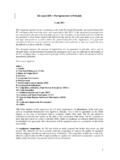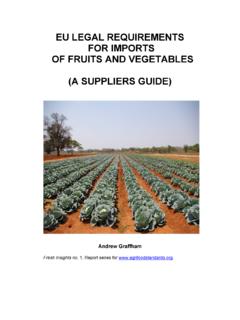Transcription of THE GRAIN INDUSTRY VALUE CHAIN IN ZIMBABWE
1 THE GRAIN INDUSTRY VALUE CHAIN IN ZIMBABWE Tinashe Kapuya1, Davison Saruchera1, Admire Jongwe2, Tolbert Mucheri2, Kingstone Mujeyi3, Lulama Ndibongo Traub4, and Ferdinand Meyer1 Prepared for the Food and Agricultural Organisation of the United Nations with funding from the EU All ACP Agricultural Commodities Programme 1 Department of Agricultural Economics, Extension and Rural Development, University of Pretoria, Pretoria 0002, Republic of South Africa, Email: T.
2 D. Saruchera< 2 Department of Agricultural Economics and Extension, University of ZIMBABWE , P. O. Box MP 167, , Harare, ZIMBABWE ., Emails: B. A., T., Mucheri 3 The African Institute for Agrarian Studies (AIAS), 19 Bodle Street, Eastlea, Harare, ZIMBABWE , E-mail: 4 Department of Agricultural Economics, University of Stellenbosch, Stellenbosch, South Africa, Email: > ii iii Preface This study was commissioned in support of an initiative coordinated by the Eastern Africa Grains Council (EAGC). The initiative, primarily funded under the USAID COMPETE programme comprises the development of a series of country case studies to map detailed staple food VALUE chains and associated trade and related policies as a basis for both national and regional level dialogue on staple foods trade policy.
3 The decision to support this process follows from the outcomes of a Consultative Workshop convened by FAO and EAGC, with funding from the EU AAACP, in June 2009. At that workshop, the lack of detailed information on the structure of GRAIN VALUE chains within the East and Southern African region was identified as a critical constraint to policy advocacy in encouraging the design of trade and related policy interventions conducive to intra-regional trade in grains that is cognizant of the both the constraints facing smallholder GRAIN producers and associated VALUE CHAIN actors, and government objectives in relation to food security and wider economic development. The current study supplements a set of seven being undertaken under COMPETE funding in recognition of the critical role of the Zimbabwean grains sector in influencing current and future staple food trade in the region.
4 A draft of the study was prepared as an input to a National Consultation held on 18th June 2010 in Harare, for validation prior to its finalisation and inclusion in a regional review process. Acknowledgements The compilation of this report would not have been possible without of the key contribution of various stakeholders that participated in the GRAIN Sector VALUE CHAIN National Consultation Workshop. Special mention goes to Peter Chapangara (Processing Manager,GMB), Bridget Mativivira (Marketing Department, GMB), Richard Taylor (Crops Manager, CFU), Elizabeth Musimwa (Agriculture Research Council) and Maurice Chinyani (Chairman, ZIMBABWE Oil Pressers Association and CEO, Surface Investments).
5 Their participation in the survey and their inputs are very much appreciated. Disclaimer The views expressed in this paper are those of the author and do not necessarily reflect those of the Food and Agriculture Organization of the United Nations, or of the European Union. iv EXECUTIVE SUMMARY Studies have shown that cross-border trade has the potential to reduce price volatility thereby moderating food price shocks within domestic markets. However despite various efforts through regional integration intra-regional trade within Eastern and Southern Africa has remained low. Analysis of staple commodity trade within the continent has cited trade policy and regulatory requirements as major constraints to efficient intra-regional trade.
6 The object of this report is to conduct a market assessment of staple food commodities within ZIMBABWE through a VALUE CHAIN Analysis (VCA) in which the impact of current policy interventions and the potential benefits of reform to these regimes in enhancing intraregional trade is explored. In particular, the maize, wheat, rice and soybean sectors are analyzed. The importance of this study lies in its ability to provide a framework for the development of a strategic plan to improve the VALUE and/or the volume of staple foods produced and marketed in ZIMBABWE in view of enhanced regional staple GRAIN trade. Section 2 of the report provides a brief overview of the relevant trade and domestic policies affecting the GRAIN subsector within ZIMBABWE .
7 The Appendices to this section outline the evolution of domestic agricultural policies. Over the past two decades or so, both domestic and trade policy interventions within the GRAIN industries of ZIMBABWE have occurred within the context of vast political and socioeconomic change. The overall goal of government during this period was to create an open and market-orientated economy that would allow for the improvement of GRAIN markets through strategic incentives and market-enabling institutions, and sustained productivity growth for the smallholder farming sector. However, up until as recently as March 2009, ZIMBABWE s GRAIN markets have largely been typified by interventionist policies.
8 The justification of such interventionist measures included market stabilization and the establishment of food security. These domestic policies have contributed to the sustained underperformance of the agricultural sector. The period between 2000 and 2008 saw a steady decline in production volumes of staple commodities and increasing reliance on food aid and imports from regional neighbours. Sections 3 through 6 present the VALUE CHAIN analysis for the maize, wheat, soybean, and rice subsector; respectively. The constraints within the maize and wheat INDUSTRY are firmly rooted at farm level. Productivity in these sectors have been poor and uncompetitive.
9 Over the past five years the national average yield has been below half a tonne per hectare in maize while in the wheat sector total annual output fell from 325,000 tonnes in 1990 to 18,500 tonnes in 2008. Key constraints to the efficient operation of these sectors have been identified. These include: limited access to market information, unreliable supply of low-cost inputs ( seed, fertiliser and electricity), limited capacity to mobilise capital for equipment purchase, high transportation costs, and the lack of enforceable policies such as sanitary and phytosanitary standards. The maize and wheat GRAIN sectors have therefore been characterised by low volume and poor quality GRAIN production relative to regional markets.
10 The constraints within the Soybean INDUSTRY occur at both the farm and processing level of the VALUE CHAIN . Overall productivity in the soybean sector has been poor and uncompetitive. This has been attributed to several factors which include: the need for increased irrigation capacity and to refurbish available irrigation facilities; improved farm level financing; reliable supply of low-cost inputs ( seed, fertiliser and electricity); increased investment in processing physical infrastructure; increased foreign direct investment; and removal of stringent importation requirements Rice production in ZIMBABWE is particularly trivial and the nation relies on imports to meet local demand.















